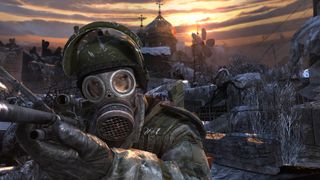
The Metro 2033 books are a perfect way to flesh out the Metro games universe and actually see what the whole series was based on in its original, unadulterated, literary form. It's a straightforward series title-wise, unlike some which can be misleading—I'm looking at you Witcher books—so its easy to know the order, but, if you're looking for extra clarity on exactly how to get started, and what to expect then you're in the right place.
The series is written by Russian author Dmitry Glukhovsky and is set in the Moscow Metro system following a world-devastating nuclear war in the year 2013. The books follow the story of Artyom who has known nothing else outside of metro, accounting his experiences of exploring the physical tunnels of the metro, but also the political divisions and factions present in them. This means getting to grips with the way people live and endure in the underground, strange beasts mutated by radiation, and his experiences with a certain supernatural element that have an ambiguous and grey introduction. If post-apocalyptic settings, devastated wastelands, carefully described misery, cramped spaces and the color gray are your things, then the Metro 2033 books are definitely for you.
If you're new to the Metro books, where should you start, and what's the reading order?

Rather pleasingly, the series has ascending numbers in the titles so you can't really go wrong. Coming at the front, chronologically in the series and in terms of release dates, you'll want to start with Metro 2033 which sets up the whole Metro universe superbly, from characters to places, from monsters to aesthetics. It also sets up and introduces readers to Glukhovsky's wider themes and commentaries that he uses his fiction to critique and give his say on. Not to give too much away but one of Metro 2033's endings is the one that Glukhovsky wrote in the book originally and this is also the one that forms the canon (chosen) ending that sets up the events of the second game Metro: Last Light—but not the next book.
While Metro 2034 is the official continuation of the Metro 2033 story line and universe, it doesn't act as a total, bona-fide or literal sequel, continuing straight on from the previous book. It's more to the side of the 'main' plot-line in the series that follows Artyom, but it does feature characters and lots of supporting information and plot-lines. It also continues the bleak, eerie, yet detailed descriptions of that world, and does plenty to reinforce the lore. It very much helped inspire Metro: Last Light, but the game is not a version of this book.
The third book, Metro 2035, also has a not-direct relationship with its third game counterpart. Instead, it is part-inspired by Metro: Last Light and mainly continues Artyom's story-line after his actions in that video game entry, and the Metro 2033 book too. Artyom is back in one of the larger Metro stations 'full-time' trying to live a quiet life but something keeps calling to him, causing him to return to the surface frequently. It's been said by Glukhovsky himself that Metro: Exodus—itself a separate story that he himself wrote with developer 4A games—continues where Metro 2035 left off and the discoveries that Artyom makes in that book. Exciting stuff, and it'll be excellent to see how the plot-lines all go together given the original author's constant input and writing between books and games.
To complete the set there is a lesser-known linking entry in the series that acts as a sort of epilogue to Metro 2033 (and is available only on Kindle) called Dmitry Glukhovsky - METRO 2033: The Gospel According to Artyom that would be worth reading to bridge the gap between 2033 and 2034, particularly if you're like me and love to hoover up all the lore available.

Why should I read them if I’ve played the games?
They are really good books and this (translation caveat included) is the way Glukhovsky has first told the Metro stories and intends them to be experienced, received and interpreted.
PC Gamer Newsletter
Sign up to get the best content of the week, and great gaming deals, as picked by the editors.
Reading the books will definitely give you a window into the wider Metro universe and enhance your understanding and perception of the world while also fleshing out the characters. It will also give you a very strong sense of belonging with the underground tunnels as communities, and the only world that Artyom has known. It will seem a more familiar place, that you can relate to more of the cast and create a stronger bond between yourself and the situations in the lore. Places will become more familiar, characters are drawn with more depth and, although much of the plot will be known to you from playing the games, the books fill in small gaps here and there.
How faithful are the Metro games to the books?

Very. And you'll start to see that straight from the first couple of chapters. The first game and book are very close and perfectly complement each other. You can see the crossover and what the game developers took from the novels particularly in terms of the environments, setting and overall aesthetic and mood of the books: every miserable, grey and atmospheric description and quality that Glukhovksy outlines in his books are brought to life in the game's oppressive and dim settings, for example. The characters, and especially the different factions along the metro lines are also great examples of this where the books set the vision, and the games truly bring them to life.
It's important to remember that Glukhovsky himself was directly involved with the work behind the games—he didn't just hand over the books and ideas. Therefore you know you're getting a consistent and authentic experience hand-guided by the author in both the books and the games.
Where can I get them?
The books are readily available, particularly from the major retailers. However, one bit of advice I would share is to just double check you've got the English translations before you hit the buy button. Unless you're an absolute whizz with languages in which case I envy you greatly. There's often a bit of difference between the cover art as well depending on what country you're shopping from (or for) but the titles will guide you true.
Some online stores give us a small cut if you buy something through one of our links. Read our affiliate policy for more info.
Most Popular




